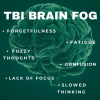Aphasia is a language impairment that affects your production and comprehension of language as well as your ability to read and write. Aphasia can immediately result from a brain injury, such as a stroke or TBI, but can also develop slowly, from a brain tumor or progressive neurological disease. Symptoms of aphasia include:
- Speaking in short or incomplete sentences
- Speaking or writing sentences that do not make sense
- Speaking unrecognizable words
- Difficulty understanding other people’s conversations
There are different types of Aphasia that can be acquired. Some of the common ones include:
| Types of Aphasia | Description |
| Global aphasia |
|
| Broca’s aphasia (non-fluent aphasia) |
|
| Mixed non-fluent aphasia |
|
| Wernicke’s aphasia (fluent aphasia) |
|
| Anomic aphasia |
|
| Primary progressive aphasia |
|
Individuals can seek speech therapy to treat aphasia. If you live with or take care of a person with aphasia, there are general strategies that you can use to communicate with him or her. These include:
- Using short, simple sentences to make language easier to understand
- Allowing time for the person to respond
- Providing clarification by repeating or writing down key words if needed
- Maintaining a natural conversation that is age appropriate
- Reducing distractions (i.e., turning off the TV or loud music)
- Encouraging any type of communication (i.e., speech, gesture, drawing)
- Avoiding correcting the person’s speech and asking too many open-ended questions
References:
https://www.nidcd.nih.gov/health/aphasia
https://www.aphasia.org/aphasia-definitions/
https://www.mayoclinic.org/diseases-conditions/aphasia/symptoms-causes/syc-20369518



